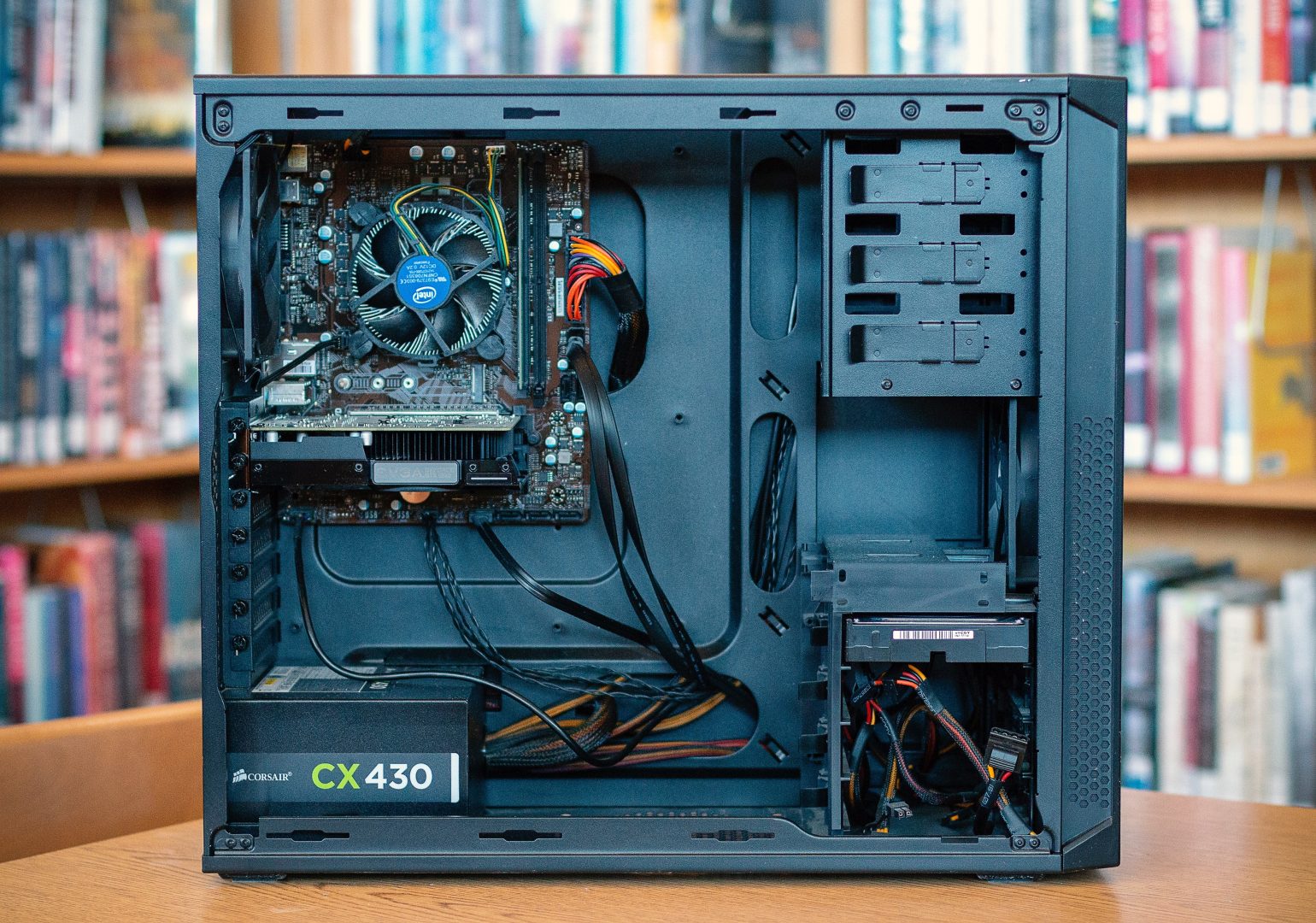[alert type=green ]You don’t have to break the bank to get into PC Gaming[/alert]
PC gaming is a very delightful prerogative and owning a high end gaming rig is even more so. Unfortunately, pre-built gaming PCs from renowned manufacturers come at unjustly high price. After inclusion of taxes an unfathomable price comes up that drowns us in an ocean of denial and remorse.
On the other hand, custom builds require extreme research and planning out the configuration on budget. People often end up buying incompatible or non – value for money components.
Don’t worry, we gotcha;)
We at Gawking Geeks have devoted our time to help you get your own custom build, budget Gaming PC. So that you don’t have to go through the trouble of doing the research, we created our picks of best parts required to build a Custom Gaming PC of 2018 in India.
Few notes before we get into the parts rationale, the configuration is solely planned out for gaming. Therefore, majority of the budget was reserved for the most important part of a gaming build, the GPU. So other components are chosen to have satisfactory specifications to help accommodate budget for a good GPU.
Even though, the components are not lowered to unacceptably low end category. It wouldn’t totally disrupt the purpose of the build, which is to deliver satisfactory gaming performance at a surprisingly low budget.
[divider]So it begins[/divider]
[button color=”green” size=”big” alignment=”center” rel=”nofollow” openin=”samewindow” url=”#”]Processor A.K.A CPU[/button]
AMD – Ryzen 3 1200 3.1GHz Quad-Core Processor
Ryzen stirred up a revolution to end Intel’s monarchy in PC CPU industry. It came with an advanced Zen microarchitecture with 14nm lithography, a new socket (AM4), new motherboard chipsets and DDR4 memory support.
With the inclusion of NVMe/SATA Express SSD support and USB 3.1 gen 2, much lesser TDP and higher clock speeds can be achieved, which can be dynamically overclocked exceeding turbo clock limits.
More cores and double threads per core, more L3 cache and a healthy 52% increase in single core IPC performance. All for a price that ravaged the rule of Intel. Our pick, Ryzen 3 1200, has all of the aforementioned benefits and is a very promising product for the price it’s asking.
Clocking at 3.1 GHz base frequency, 3.4 GHz Turbo frequency and 4 cores with a wholesome 8MB of L3 cache all for sipping a meagre 65W of power. We couldn’t have declined this baby Ryzen over the i3, and yes, it can be overclocked, both automatically (XFR) and manually.
[button color=”green” size=”big” alignment=”center” rel=”nofollow” openin=”samewindow” url=”#”]Motherboard[/button]
MSI – B350 GAMING PLUS ATX AM4 Motherboard
Once the CPU is decided, it becomes easy to decide the motherboard. The choices available for the chosen CPU socket becomes limited and a budget bracket further narrows down the options.
Along with Ryzen, AMD launched new age motherboard chipsets to compliment the added features of the Ryzen CPUs. AMD’s B350 chipset is a very promising offering with addons over the essentials in the A320 chipset. MSI B350 Gaming Plus is an ATX size motherboard with 4 RAM slots that has up to 64GB of DDR4 Memory support and frequencies up to 3200 MHz.
Supports RAID and CPU overclocking. Aesthetically, the board features a lava line LED design and red and black accenting. MSI offers rock solid VRM and power delivery design to happily overclock your Ryzen 1200.
[button color=”green” size=”big” alignment=”center” rel=”nofollow” openin=”samewindow” url=”#”]RAM[/button]
G.Skill – Ripjaws 4 series 8GB (2 x 4GB) DDR4-2400 Memory
G.Skill has been a very renowned name in the Memory industry, setting up overclocking records and setting benchmarks for quality standards. The G.Skill – Ripjaws 4 series 8GB (2 x 4GB) DDR4-2400 Memory kit is no exception. The red heat spreader compliments the overall accenting on the motherboard so serves a pleasing appeal to the finished build.
[button color=”green” size=”big” alignment=”center” rel=”nofollow” openin=”samewindow” url=”#”]Storage[/button]
SanDisk – SSD PLUS 120GB 2.5″ Solid State Drive
SanDisk – SSD PLUS 120GB Solid State Drive is one of the products in the market right now that is accessible to current HDD users. Current 2.5” SSD market is flooded with offers of entry level SSDs that can dramatically reduce the boot times of your PC and increase responsiveness.
Trust us, once you go SSD, there’s no turning back. But our limited budget restricted us to a size of only 120 GB. We don’t recommend anything more than the OS and few important apps that are staple in your system to be placed on the SSD. The OS performance would be boosted substantially over single HDD option, take our word.
Western Digital – Caviar Blue 1TB 3.5″ 7200RPM Internal Hard Drive
1 TB is considered a standard size nowadays and budget restrain prevented us from getting a 2 TB HDD and unfortunately, there has been a sudden price hike in storage prices. However, the WD Blue yet comes at an attractive price tag. The sad part is that it comes in maximum 1 TB capacity, so if you can or want to move up to 2 TB then you might want to get WD Black or Seagate Barracuda 2 TB 7200 RPM HDDs. WD have been an old player in the market.
With years of constant evolution, the Caviar Blue series has evolved to be the fastest 1 TB HDDs in the market when it comes to its price. Sure the specs may look standard, with 7200 RPM spindle spin rate and 64 MB cache buffer to speed things up a little, the single 1 TB platter design reduces seek times to bare minimum and doesn’t make you feel you’re not on the premium side of things at all.
Storage is a very flexible option, so you can go your ways in this part without hurting much performance.
[button color=”green” size=”big” alignment=”center” rel=”nofollow” openin=”samewindow” url=”#”]G.P.U[/button]
Asus – GeForce GTX 1050 Ti 4GB Phoenix Video Card
Here comes the jewel of every Gaming PC, the GPU a.k.a the Graphics Card. The most important component to play games at your preferred visuals, therefore you can see that this is the most expensive part in our build.
This is the part which deserves this much reservation at any budget of any gaming build. The GTX 1050 Ti is one of the most popular GPUs coming from NVIDIA which offers enough VRAM (4GB of GDDR5 memory) clocked at 7000 MHz+ with a GPU core based on the phenomenal 16nm Pascal architecture. It support CUDA, 3D Vision, PhysX, NVIDIA G-SYNC™, Ansel technologies, with 768 CUDA cores and just a simple 75W of TDP.
Asus’ Phoenix edition has an in house built GPU cooler that makes sure the card run cooler under prolonged loads. GTX 1050 Ti is proven to be a 1080p suited card which can run AAA titles on med-high settings at 60 FPS and maxing out lesser demanding titles at 1080p with solid 60FPS.
[button color=”green” size=”big” alignment=”center” rel=”nofollow” openin=”samewindow” url=”#”]Case/Cabinet[/button]
Corsair – 100R ATX Mid Tower Case
Corsair is a revered name in the PC component market, catering entry level consumers to high end enthusiasts with their wide spectrum of products. Good thing about Corsair products is that even the entry level ones are bleeding with quality if not with features. The Carbide 100R is one such case, that has decent build quality, spacious interior and good airflow to facilitate the proper functioning of the PC under long gaming sessions.
[button color=”green” size=”big” alignment=”center” rel=”nofollow” openin=”samewindow” url=”#”]Power Supply Unit/SMPS[/button]
Corsair – CX (2017) 550W 80+ Bronze Certified ATX Power Supply
With a promise of 5 years under warranty, the Corsair CX550 is the 2017 version of the legacy CX500 with 50W more power and improved thermal and power delivery consistency. The black sleeved cables and all black shroud is a perfect fit in our case. The lateral mounted large fan keeps the internal circuitry running cool.
One thing to look for in a PSU while building a gaming rig is the current rating given in Amperes (A) on the 12 Volt rail. It is the voltage rail that powers the critical components like CPU and GPU, the higher the better. Always keep at least 80W on reserve on power wattage. In simpler words, if the total power consumption of your rig is around 300W, buying a 350W PSU is not a smart choice, rather getting a 450W results in safety rather than overkilling.
Remember PSU is a component in which if you cut costs, it will backfire taking down every other component with itself. Therefore, never ever go cheap on the PSU and always buy branded PSUs from renowned manufacturers after reading reviews about it.
PCPartPicker part list / Price breakdown by merchant
| Type | Item | Price |
|---|---|---|
| CPU | AMD – Ryzen 3 1200 3.1GHz Quad-Core Processor | ₹6180.00 @ Amazon India |
| Motherboard | MSI – B350 GAMING PLUS ATX AM4 Motherboard | ₹7999.00 @ Amazon India |
| Memory | G.Skill – Ripjaws 4 series 8GB (2 x 4GB) DDR4-2400 Memory | ₹6225.00 @ Amazon India |
| Storage | SanDisk – SSD PLUS 120GB 2.5″ Solid State Drive | ₹2386.00 @ Amazon India |
| Storage | Western Digital – Caviar Blue 1TB 3.5″ 7200RPM Internal Hard Drive | ₹3184.00 @ Amazon India |
| Video Card | Asus – GeForce GTX 1050 Ti 4GB Phoenix Video Card | ₹14647.00 @ Amazon India |
| Case | Corsair – 100R ATX Mid Tower Case | ₹3597.00 @ Amazon India |
| Power Supply | Corsair – CX (2017) 550W 80+ Bronze Certified ATX Power Supply | ₹4999.00 @ Amazon India |
| Prices include shipping, taxes, rebates, and discounts | ||
| Total | ₹49217.00 | |
| Generated by PCPartPicker 2018-07-12 13:25 IST+0530 |
With this we conclude our build guide and hope you liked it and this cleared off the cloud of confusion hovering between you and you next gaming PC.
Problems and queries are undertaken under the comments section and your opinions are most welcomed.




